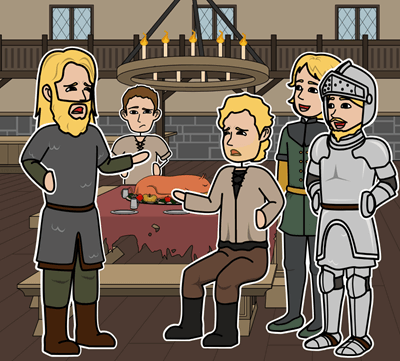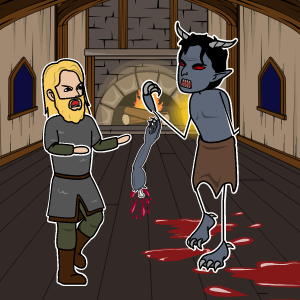Lesson Plan Overview
As students read, a storyboard can serve as a helpful character reference log. This log (also called a character map) allows students to recall relevant information about important characters. A story like Beowulf has many characters to keep track of and a character log can help keep them straight.
Clicking "Use This Assignment" will copy both the example above as well as a blank template for you to customize as desired. You may want students to start from scratch, or provide them with the questions and characters! Additionally, feel free to add your own questions for students to keep track of.
Important Characters and Creatures
- Beowulf - Brave warrior and future king of Geatland
- King Hrothgar - King of the Dane's who is threatened by the monster Grendel
- Grendel - A abominable monster who threatens the Danes
- Grendel’s mother - A swamp hag
- Beow - Former King of the Geats
- Unferth - Antagonist who challenges Beowulf on his word
- Wiglaf - A young warrior who follows Beowulf to his death
Template and Class Instructions
(These instructions are completely customizable. After clicking "Copy Activity", update the instructions on the Edit Tab of the assignment.)
Student Instructions
Create a character map for the major characters.
- Identify the major characters in Beowulf and type their names into the different title boxes.
- Choose a character from the "Medieval" or "Monsters and Myths" tabs to represent each of the literary characters.
- Select colors and a pose appropriate to story and character traits.
- Choose a scene or background that makes sense for the character.
- Fill in the text boxes for Traits, Role in Epic, and Effect on Protagonist.
Lesson Plan Reference
Student Rubric
(You can also create your own on Quick Rubric.)
| Proficient 33 Points | Emerging 25 Points | Beginning 17 Points | |
|---|---|---|---|
| Character Picture & Scene | The characters and scenes are both appropriate for the book's characters. | Many of the characters and scenes match the book's characters. | More than half of the characters and scenes do not match the characters in the book. |
| Accuracy of Notes | Most of the information of the notes is correct. | Many of the notes have correct information, but some are incorrect or missing. | Less than half of the information of the notes is correct and relevant. |
| Effort | Work is complete, thorough, and neat. | Most of the sections of the character map were at least attempted and work is presentable. | Character map is unfinished and/or disorganized. |
Lesson Plan Overview
As students read, a storyboard can serve as a helpful character reference log. This log (also called a character map) allows students to recall relevant information about important characters. A story like Beowulf has many characters to keep track of and a character log can help keep them straight.
Clicking "Use This Assignment" will copy both the example above as well as a blank template for you to customize as desired. You may want students to start from scratch, or provide them with the questions and characters! Additionally, feel free to add your own questions for students to keep track of.
Important Characters and Creatures
- Beowulf - Brave warrior and future king of Geatland
- King Hrothgar - King of the Dane's who is threatened by the monster Grendel
- Grendel - A abominable monster who threatens the Danes
- Grendel’s mother - A swamp hag
- Beow - Former King of the Geats
- Unferth - Antagonist who challenges Beowulf on his word
- Wiglaf - A young warrior who follows Beowulf to his death
Template and Class Instructions
(These instructions are completely customizable. After clicking "Copy Activity", update the instructions on the Edit Tab of the assignment.)
Student Instructions
Create a character map for the major characters.
- Identify the major characters in Beowulf and type their names into the different title boxes.
- Choose a character from the "Medieval" or "Monsters and Myths" tabs to represent each of the literary characters.
- Select colors and a pose appropriate to story and character traits.
- Choose a scene or background that makes sense for the character.
- Fill in the text boxes for Traits, Role in Epic, and Effect on Protagonist.
Lesson Plan Reference
Student Rubric
(You can also create your own on Quick Rubric.)
| Proficient 33 Points | Emerging 25 Points | Beginning 17 Points | |
|---|---|---|---|
| Character Picture & Scene | The characters and scenes are both appropriate for the book's characters. | Many of the characters and scenes match the book's characters. | More than half of the characters and scenes do not match the characters in the book. |
| Accuracy of Notes | Most of the information of the notes is correct. | Many of the notes have correct information, but some are incorrect or missing. | Less than half of the information of the notes is correct and relevant. |
| Effort | Work is complete, thorough, and neat. | Most of the sections of the character map were at least attempted and work is presentable. | Character map is unfinished and/or disorganized. |
How To Discuss Character Dynamics in Beowulf
List Down Characters
Ask the students to make a list of all the key characters or the characters they are interested in understanding. Some of the main characters in Beowulf include Beowulf himself, Grendel the monster, King Hrothgar, Grendel's mother, Unferth and Wiglaf.
Explore Relationships
They can also analyze which characters have the most interactions and which characters have the least interactions. They can list down the key points such as how these relationships and interactions influence behaviors and actions.
Analyze Character Traits
Understand the unique character traits that each character possesses and hold a discussion on why it was important for this character to possess such traits. Students can try to make their personalities more descriptive by modernizing the characters according to the real world.
Organize Role-Playing Activities
Teachers can organize a role-play activity and students can pick their favorite characters that they want to play. The poem can be converted into a play and some scenes can be recreated in order to get a better understanding of the characters.
Reflect on Activities
After playing different characters, students can write a short essay explaining their own perspective of the characters and the character dynamics they understood after participating in all the activities.
Frequently Asked Questions About Beowulf Character Map
What exactly is a character map and how can it help in understanding the poem more effectively?
A character map is a visual portrayal of the characters' relationships, qualities, and interactions in the epic poem "Beowulf." It aids in understanding the relationships and dynamics between diverse characters. A character makes it simpler to see how the characters interact, affect the story, and represent different themes. Teachers can use this activity to explain difficult and abstract concepts in an efficient and interesting manner.
What are some "Beowulf" character relationships to pay attention to?
Beowulf's encounters with King Hrothgar, his conflicts with Grendel and Grendel's mother, and his partnership with Wiglaf are important relationships that students should pay attention to as they change the whole dynamic of the story. You can also look into the conflicts between characters like Unferth and Beowulf and the devotion of warriors to their monarchs.
How can I efficiently use colour and symbols in the character map?
To visually identify characters or groups of characters, give them various colours or symbols. You may, for instance, choose one colour for heroic people and another for adversarial ones. Character-related traits, allegiances, or themes can be represented through symbols.
More Storyboard That Activities
Beowulf
This Activity is Part of Many Teacher Guides
Testimonials

“By using the product, they were so excited and they learned so much...”–K-5 Librarian and Instructinal Technology Teacher

“I'm doing a Napoleon timeline and I'm having [students] determine whether or not Napoleon was a good guy or a bad guy or somewhere in between.”–History and Special Ed Teacher

“Students get to be creative with Storyboard That and there's so many visuals for them to pick from... It makes it really accessible for all students in the class.”–Third Grade Teacher
© 2025 - Clever Prototypes, LLC - All rights reserved.
StoryboardThat is a trademark of Clever Prototypes, LLC, and Registered in U.S. Patent and Trademark Office









